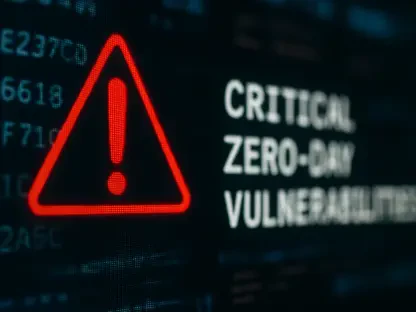In a chilling development within the cybersecurity landscape, a sophisticated campaign orchestrated by a China-nexus threat actor has come to light, targeting web servers across East Asia with unprecedented stealth and precision, marking a significant escalation in cyber threats. This operation, active since earlier this year, focuses on critical regions such as Taiwan, Japan, South Korea, and Hong Kong, exploiting vulnerabilities in public-facing applications to deploy advanced malware. Uncovered by cybersecurity experts, the attack marks a disturbing milestone as it represents the first documented instance of Nezha, a legitimate server management tool, being repurposed for malicious purposes. The attackers’ innovative tactics, including log poisoning and the use of trusted software to evade detection, underscore a growing trend among threat actors to blur the lines between legitimate and harmful activity. This alarming scenario raises urgent questions about the security of widely used tools and the evolving nature of cyber threats in a geopolitically charged environment.
Unpacking the Attack Mechanics
Initial Breach and Access Tactics
The campaign’s entry point reveals a calculated approach to exploitation, beginning with the compromise of an unsecured phpMyAdmin panel traced back to an AWS-hosted IP in Hong Kong. Attackers leveraged this vulnerability to gain a foothold, employing a log poisoning technique that manipulated MariaDB’s logging functions to embed a PHP web shell within the server’s webroot. This backdoor enabled the execution of arbitrary code through tools like AntSword, granting initial control over the compromised system. The ingenuity of this method lies in its ability to hide malicious activity within seemingly benign log files, making detection by traditional security measures incredibly challenging. Such tactics highlight the attackers’ deep understanding of server environments and their determination to exploit even the smallest oversight in configuration, turning a routine administrative tool into a gateway for broader infiltration.
Beyond the initial breach, the attackers swiftly moved to solidify their presence by downloading and installing a Nezha agent, disguised as a legitimate monitoring tool. However, this agent was configured to communicate with a command-and-control (C2) server, transforming it into a conduit for malicious instructions. The Nezha dashboard, notably set to the Russian language, revealed a staggering scope of over 100 compromised machines across 53 regions, with a clear focus on East Asian targets. This strategic targeting aligns with broader geopolitical interests often associated with state-sponsored actors. The use of Nezha not only ensured stable access but also blended seamlessly into normal server operations, complicating efforts to identify and mitigate the threat before further damage could be inflicted.
Escalation and Malware Deployment
Once entrenched, the attackers escalated their control by initiating a PowerShell session to disable Windows Defender through a carefully crafted exclusion rule, effectively neutralizing a key line of defense. This paved the way for the deployment of a variant of Ghost RAT, a malware strain historically linked to Chinese advanced persistent threat (APT) groups. Ghost RAT facilitated deeper infiltration, enabling data exfiltration and sustained access to compromised systems. The malware’s communication protocols and persistence mechanisms mirrored patterns observed in prior campaigns attributed to similar actors, reinforcing the connection to a China-nexus operation. This phase of the attack underscores the attackers’ intent to not only breach systems but to maintain long-term dominance over them, exploiting trusted environments for espionage or other strategic gains.
Further analysis of the attack revealed specific indicators of compromise, including file paths and associated C2 infrastructure. For instance, the Nezha agent, masquerading as “live.exe,” was found in the “C:\Windows\Cursors” directory, alongside the Ghost RAT payload labeled “x.exe.” Accompanying domains like “c.mid[.]al” served as communication hubs for the malware, illustrating the attackers’ reliance on established infrastructure to coordinate their efforts. This meticulous layering of tools and techniques demonstrates a high level of sophistication, as the attackers continuously adapted their methods to evade detection. The combination of disabling security controls and deploying potent malware like Ghost RAT paints a grim picture of the potential consequences for targeted organizations, particularly in sensitive regions.
Broader Implications and Defense Strategies
Rising Trend of Tool Abuse
A defining characteristic of this campaign is the tactical shift toward weaponizing legitimate software like Nezha, a practice that allows attackers to operate under the radar by blending into routine server activities. This approach reflects a broader trend among threat actors to exploit trusted tools, bypassing conventional security measures that often fail to flag familiar applications as threats. The abuse of open-source or widely accepted software complicates the task of distinguishing between normal and malicious behavior, as administrators may overlook subtle anomalies in tools they rely on daily. This growing reliance on legitimate software for illicit purposes signals a critical need for security teams to rethink detection strategies, focusing on behavioral analysis rather than solely on known signatures of malicious code.
The focus on East Asian targets further suggests a strategic intent, likely tied to espionage or geopolitical motives, consistent with patterns observed in historical activities of Chinese APT groups. The attackers’ ability to compromise over 100 machines across multiple regions indicates a well-resourced operation with clear objectives. This campaign serves as a stark reminder that cyber threats are not random but often aligned with larger political or economic goals. Organizations in vulnerable regions must recognize the heightened risk and prioritize securing their digital assets against adversaries who exploit both technical vulnerabilities and geopolitical tensions to achieve their aims. The intersection of technology and global strategy in this attack amplifies the urgency for robust, context-aware defenses.
Strengthening Cybersecurity Postures
In response to this evolving threat landscape, organizations must urgently harden public-facing applications to prevent initial access through vulnerabilities like unsecured phpMyAdmin panels. Implementing strict access controls, regular patching, and continuous monitoring for unusual activity can significantly reduce the attack surface. The attackers’ success in disabling security tools like Windows Defender highlights the importance of layered defenses, where no single point of failure can compromise the entire system. Proactive threat hunting, focused on identifying anomalies in trusted software behavior, is equally critical to detecting campaigns that leverage tools like Nezha. By adopting a multifaceted approach, businesses can better safeguard their infrastructure against increasingly sophisticated adversaries.
Looking back, this incident exposed the vulnerabilities inherent in trusting widely used software without rigorous scrutiny, as attackers adeptly turned Nezha into a weapon for espionage and control. The campaign’s reliance on advanced techniques like log poisoning and malware such as Ghost RAT revealed the lengths to which threat actors will go to achieve persistence. Moving forward, the cybersecurity community must advocate for enhanced monitoring frameworks and share actionable intelligence on emerging tactics. Organizations should also invest in training to recognize the misuse of legitimate tools and collaborate on developing adaptive security measures. This episode serves as a crucial lesson, urging a collective push toward resilience in an era where the line between trusted and malicious blurs with alarming ease.









